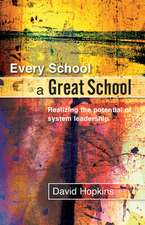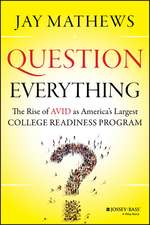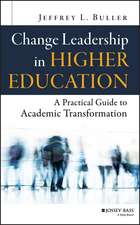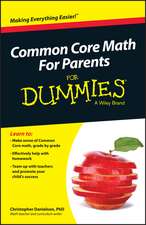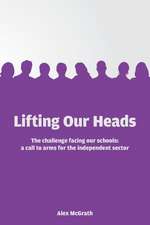Cuprins
Preface
Part I: The Contemporary Context of Teacher Supervision and Evaluation
Chapter 1: The Context for Instructional Supervision
Introduction
A Day in the Life of a PrincipalLessons from the Narrative
The Difficulty of Defining a Role or Function like SupervisionThe “New” Standards-based Accountability
The Diversity Policy AgendaFollow Up Activities to Chapter 1
ReferencesChapter 2: Contemporary Issues Around Fairness in Supervision
Introduction
External Influences That Impact Performance on State and District TestsInternal Influences that Impact Performance on State and District Tests
The Limitations and Misuse of State Tests and the Unwarranted Judgments Connected with Their “Results”Issues of Fairness within the Supervisory Process Itself
SummaryFollow Up Activities
ReferencesChapter 3: Issues around “Data Driven” Decision Making in Supervision
Data and Its Use
Some BackgroundData
Data UseThe Learning Community Context
The Knowledge Management PerspectiveOrganizational Knowledge
The Unique Properties of Knowledge
Conclusion: The Importance of Data-Informed ReflectionActivities
Building a Learning CommunityReferences
Chapter 4: Issues Around Cultural Responsiveness
Cura Personalis
Elements of Culturally Responsive PedagogyPotential Misperceptions about Culturally Responsive Pedagogy
Culture, Poverty, and SchoolsWho is Served by Culturally Responsive Pedagogy?
Enacting Culturally Responsive PedagogyThe Needs of Immigrant Children
Addressing Regional Patterns of Economic and Racial SegregationImplications for Supervision
ConclusionActivities
ReferencesPart II: Foundations for Supervisors
Chapter 5: Supervisors’ Perspectives on Human Development
Introduction
Erikson’s Model of Human GrowthImplications for Supervisors
Journal ReflectionsReferences
Chapter 6: Supervisors’ Perspectives on Curriculum
Introduction
Accountability for Curriculum StandardsWays Teachers Might Think About Curriculum
The Curriculum and Membership in the WorldThe Immediacy of the Social Curriculum
The Curriculum as Planned, as Taught, as Learned, and as AssessedThe Curriculum as Planned
The Curriculum as TaughtThe Curriculum as Learned
The Curriculum as AssessedWhere is the Curriculum?
Conclusions and ImplicationsThe Unattended and Unrealized Curriculum of Membership
ActivitiesReferences
Chapter 7: Supervisors’ Perspectives on Teaching and Learning
Introduction
Student Informal Experiential LearningThe Schooling Experience
The Learned World of the TeacherLearning as Sense-Making
Pushing for Depth of LearningThe Activity of Teaching
Teaching and Learning in a Dysfunctional InstitutionSupervisors’ Applications of the Triangle Model
The Focus on Quality Learning for All StudentsSummary
ActivitiesReferences
Chapter 8: Supervisors’ Perspectives on the Assessment of Student Learning
The Formal Assessment of Student Learning
Purposes Behind Assignments
Assessment Types and Their FeaturesTechnologies and Assessment
Implications for SupervisorsCultivate an "Attitude of Wisdom"
Rethinking the Cycle of InquiryThe Overall System of Assessment
Conclusion
ActivitiesReferences
Part III: The Practice of Supervision
Chapter 9: Supervision and Evaluation: Confusions and ClarificationsIntroduction
Evaluation by WhomModifying the Language of Supervision: Assessment vs. Evaluation
Purposes of Supervisory ActivityThe Emergence of Teacher Leadership
Formative and Summative Supervisory ActivitySummative Supervision
A Redefinition of Formative Teacher SupervisionSummative Teacher Supervision
Applications of Formative SupervisionApplications of Summative Evaluation
SummaryActivities
ReferenceChapter 10: Formative Supervision
Introduction
Clinical SupervisionThe Cycle of Clinical Supervision
Pre-Observation ConferenceObservation of Teaching
Analysis and Organization of the Data for FeedbackPost-Observation Conference
The Post-Observation AnalysisUnrealistic Time Demands on Supervisors
Similarities of the Dynamics in Clinical Supervision and CoachingThe Virtue of Presence in Formative Assessment
Presence as a VirtueAffirming Presence
Enabling PresenceCritical Presence
SummaryActivities
ReferencesChapter 11: Supervision and Summative Assessments
Introduction
Major Influences on New Summative Assessment PracticesThe National Board for Professional Teaching Standards (NBPTS)
Teacher Advancement Program (TAP)Frameworks for Teaching (FFT)
A Professional Development Culture
State InitiativesCommon Conceptions of State Initiatives Connected to Summative Teacher Assessments
Conclusion: A Redefinition of Summative EvaluationReferences
Chapter 12: Central Office Support for Supervision
Central Offices and the Policy Environment
State Standards for Teacher Evaluation
Teacher Incentive PaySupporting Supervision from the District-Level
A Vision for Supervision
Developing Supervisors’ Knowledge and SkillsAddress Political and Practical Challenges Around Evaluation
Embracing Central Office’s Place in the Policy ChainConclusion
ActivitiesReferences
Chapter 13: Supervision and the Renewal of Schools
Introduction
Some BackgroundIntellectual and Moral Dimensions of Supervisory Leadership
A Transition from Bureaucratic to Organic ManagementAdvocate for Student Learning
Some ReflectionsIndex



